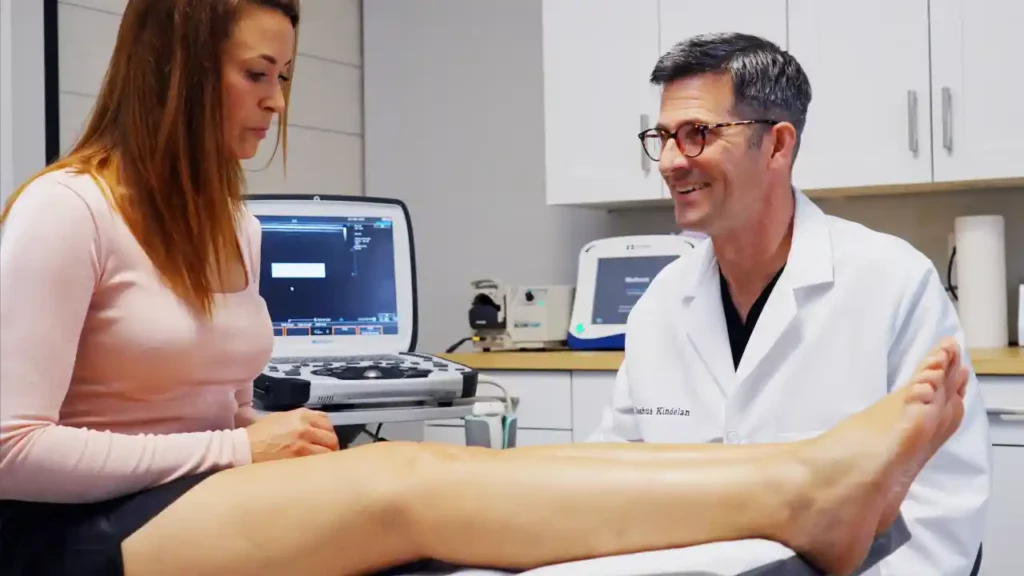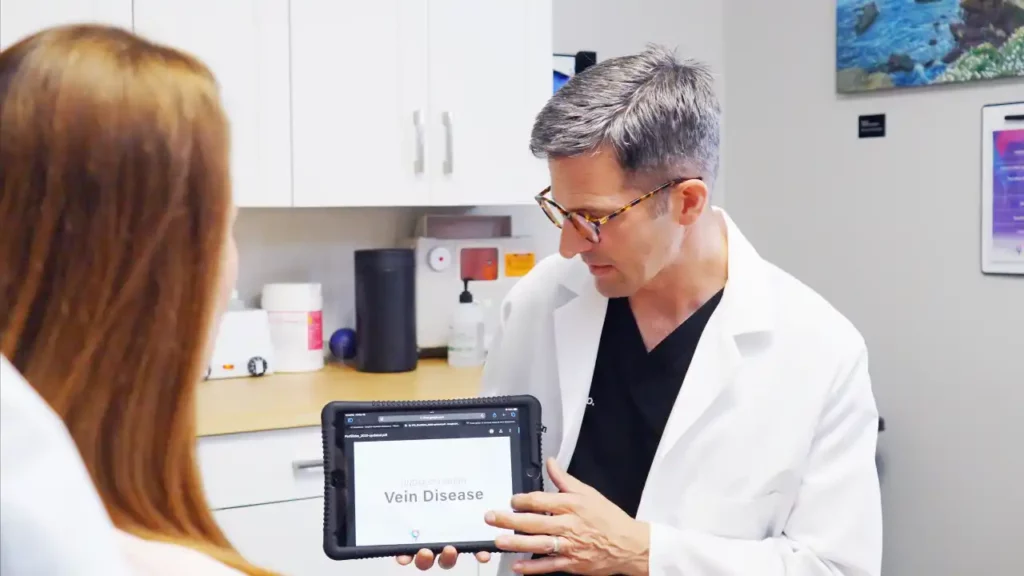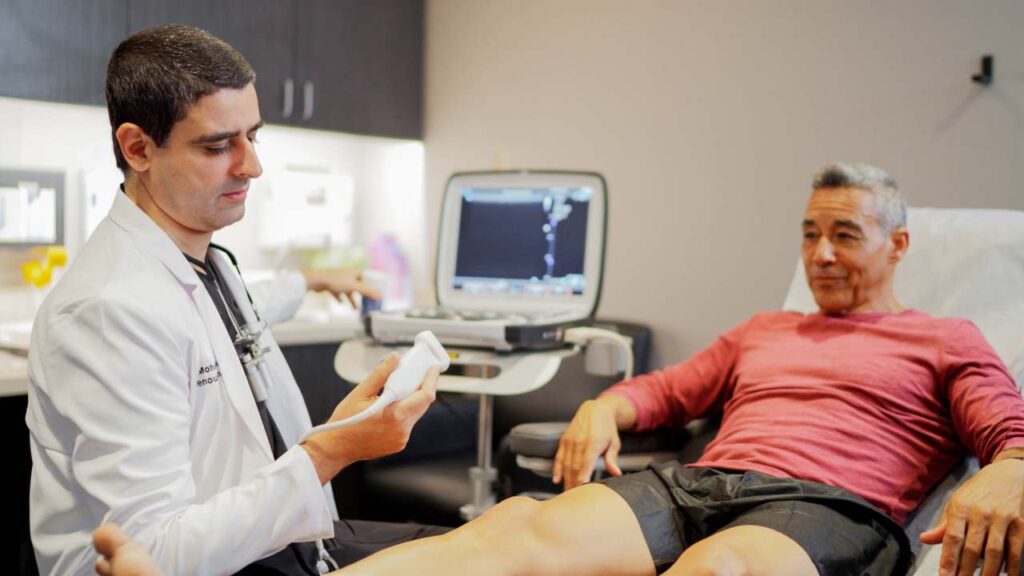What is a vein center?
A vein center is a medical center dedicated to the diagnosis and treatment of vein problems. Vein centers deal with phlebology, the branch of medicine focusing veins and vascular health. When you visit a varicose vein center in California, you can expect a thorough diagnosis of your vein problems followed by a minimally invasive vein treatment.
What does a vein doctor do?
A vein doctor, officially known as a phlebologist, specializes in the diagnosis and treatment of vein disease. Vein doctors can come from all fields of medicine, including anesthesiology, dermatology, cosmetic surgery, and cardiology, as long as they have specialized training in minimally invasive vein treatments. You should consult board-certified vein doctors who examine the root cause of your spider veins and varicose veins to curate personalized minimally invasive vein treatment plans.
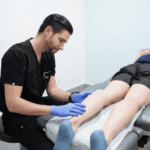
What can I expect at a vein clinic?
We can’t speak for all vein clinics because different medical centers follow different sets of protocols and provide different treatments. Some vein clinics focus on cosmetic relief from spider veins, whereas others provide comprehensive vein treatments. Some vein clinics provide vascular surgery (even though they’re now considered obsolete), and others provide minimally invasive vein treatments in California. Our spider vein and varicose vein treatment centers in California specialize in comprehensive, minimally invasive vein treatments.
Below, we provide a step-by-step overview of what you can expect from our vein clinic in CA.
Diagnosis
Your spider vein and varicose vein treatment start with a thorough diagnosis and consultation. Our vein doctors examine your leg veins, discuss your symptoms, and review your medical history. You should be completely honest and transparent with your vein doctor during the diagnosis — leg heaviness, leg cramps, restless leg syndrome, and leg swelling are common signs and symptoms of vein disease, especially if they worsen at the end of the day or after long periods of sitting or standing still.
After the physical examination and consultation, the vein doctor will schedule an ultrasound diagnostic test called duplex ultrasound. During this test, the vein doctor will use ultrasound energy to visualize the direction of blood flow in your leg veins, which will conclusively determine if you have chronic venous insufficiency. Based on the diagnostic results and your unique symptoms, the vein doctor will curate a personalized minimally invasive vein treatment plan. Our vein doctors walk you through every step of the vein treatment process.
Treatment
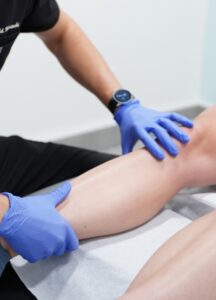 If you have chronic venous insufficiency, your vein treatment will start with radiofrequency ablation, endovenous laser ablation, or VenaSeal. During the ablation treatments, the vein doctor will make a small incision on the skin’s surface to insert a catheter into the diseased vein. Once lodged in place, the vein doctor will channel thermal energy or laser energy to destroy the diseased vein responsible for your vein problems, restoring optimal blood circulation. VenaSeal involves sealing the diseased vein’s walls using a medical-grade adhesive.
If you have chronic venous insufficiency, your vein treatment will start with radiofrequency ablation, endovenous laser ablation, or VenaSeal. During the ablation treatments, the vein doctor will make a small incision on the skin’s surface to insert a catheter into the diseased vein. Once lodged in place, the vein doctor will channel thermal energy or laser energy to destroy the diseased vein responsible for your vein problems, restoring optimal blood circulation. VenaSeal involves sealing the diseased vein’s walls using a medical-grade adhesive.
If you don’t have chronic venous insufficiency or after the primary vein treatment, the vein doctor will perform spider vein and varicose vein removal. Sclerotherapy is the best spider vein treatment. It involves injecting a sclerosant solution into spider veins to make them shrink and turn into hardened tissues eventually absorbed by the body. Ambulatory phlebectomy is the best cosmetic treatment to remove superficial varicose veins. The vein doctor will make small incisions on the skin’s surface to extract the unwanted varicose veins.
Recovery
Minimally invasive vein treatments usually conclude within 30 to 60 minutes. After your procedure, the vein doctor will apply pressure on your legs while you stand up to prevent blood from accumulating in your leg veins. You may feel mild discomfort, swelling, and irritation on your legs once the anesthesia wears off, but you can manage the discomfort with over-the-counter medications. You may have to wear compression stockings for a few weeks, but you can resume your daily activities immediately.
How does vein treatment work?
Radiofrequency Ablation
The vein doctor makes a small incision on the skin’s surface to insert a catheter under ultrasound guidance. The catheter is driven into the diseased saphenous vein and activated to generate radiofrequency energy, which destroys the diseased vein. The accumulated blood reroutes into healthier leg veins.
Laser Ablation
The vein doctor makes a small incision on the skin’s surface to insert a laser fiber under ultrasound guidance. The laser fiber is driven into the diseased vein and activated to generate laser energy, collapsing the problematic vein responsible for your problems. The accumulated blood reroutes into healthier leg veins.
ClariVein
The vein doctor makes a small incision on the skin’s surface and inserts a catheter with a specialized rotating tip. The catheter is guided into the diseased vein under ultrasound guidance. When activated, the rotating tip damages the vein’s walls while injecting sclerosant medicine, which fuses the diseased varicose veins’ walls, making it shrink and collapse.
VenaSeal
The vein doctor injects a medical-grade adhesive into the diseased saphenous vein. The vein glue fuses the diseased vein’s walls, turning it into a hardened tissue eventually absorbed by the body.
Ambulatory Phlebectomy
The vein specialist makes small incisions on the skin’s surface to manually extract the superficial varicose veins. The incision marks gradually heal into scars that fade away from the skin’s surface.
Sclerotherapy
The vein physician injects a medicine called sclerosant into your spider veins — one injection per spider vein. The sclerosant medicine fuses the spider veins’ walls, turning them into hardened scar tissues eventually absorbed by the body. The spider veins fade away from your skin’s surface as they’re metabolized by the body.
